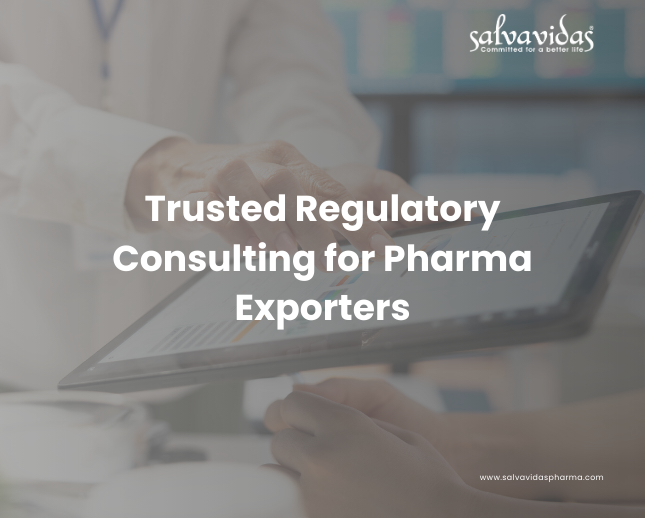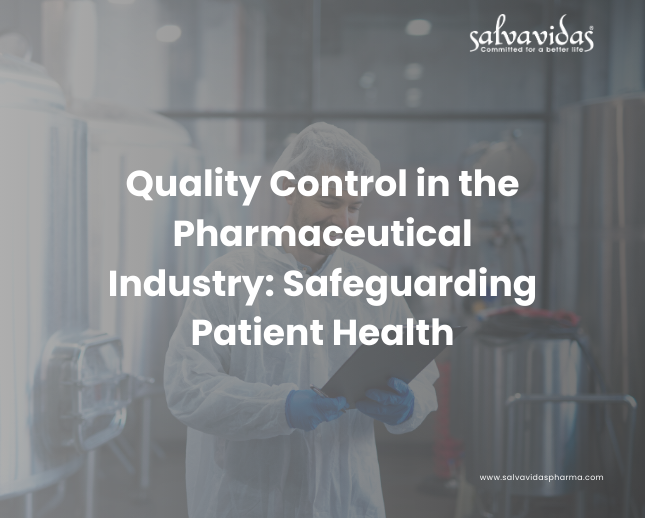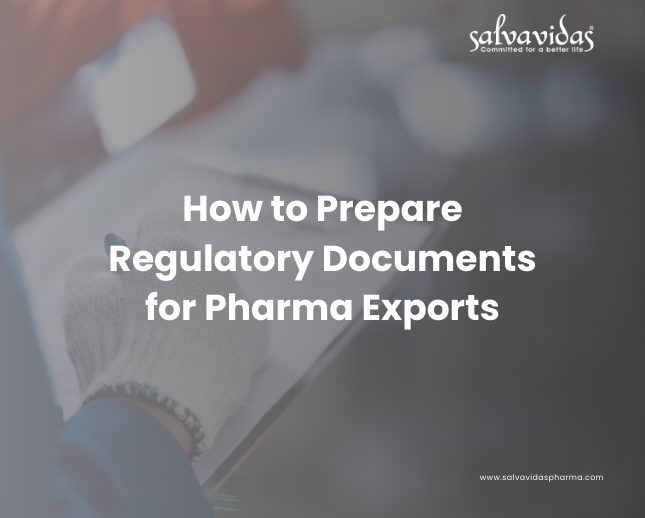
Regulatory Consulting for Pharma Exporters In the pharmaceutical industry, compliance is not optional—it is the foundation of trust, safety, and global market access. For companies aiming to expand internationally, navigating diverse regulatory frameworks can be overwhelming. This is where regulatory consulting for pharma companies becomes crucial. At Salvavidas Pharmaceutical, we provide specialized regulatory consulting that simplifies compliance, ensures smooth approvals, and accelerates your entry into international markets. Why Regulatory Consulting Matters in Pharma Exports Pharmaceutical exports involve strict oversight from regulatory authorities worldwide. A single error in compliance can lead to shipment delays, product rejections, or even financial losses. Regulatory consulting helps you: Understand country-specific requirements Reduce risks of non-compliance Save time with faster approvals Build credibility with global partners Focus on business growth while experts handle compliance Key Areas of Regulatory Consulting for Pharma Companies 1. Product Registration & Approval Every market has its own requirements for product dossiers, licenses, and clinical data. Our experts prepare and submit accurate documentation to speed up approvals. 2. Dossier Preparation (CTD/ACTD Formats) We help compile high-quality dossiers covering product composition, manufacturing process, and quality control, tailored to global submission standards. 3. Regulatory Documentation Support From COPP and CoA to FSC and labeling approvals, we ensure all required documents are prepared and compliant with international guidelines. 4. Labeling & Packaging Compliance We review and adapt labeling to meet the importing country’s regulations, ensuring safety information is clear and approved. 5. Post-Approval Regulatory Support Regulations evolve, and continuous compliance is essential. We provide ongoing monitoring and guidance to keep your approvals valid. Benefits of Partnering with Salvavidas for Regulatory Consulting Expert Guidance: Experienced professionals with deep knowledge of international pharma regulations. Tailored Solutions: Customized consulting based on your target markets. End-to-End Support: From dossier preparation to post-approval maintenance. Global Reach: Assistance in exports across Africa, Asia, Latin America, and beyond. Compliance Assurance: We minimize risks and maximize your chances of approval. Conclusion Expanding into global markets requires more than just high-quality pharmaceutical products—it demands strict regulatory compliance. With Salvavidas Pharmaceutical’s regulatory consulting for pharma companies, you gain a reliable partner who ensures your business stays compliant, efficient, and competitive worldwide. 📞 Contact Salvavidas today to simplify compliance and accelerate your international success.

Quality control in pharmaceutical industry In today’s tightly regulated pharmaceutical world, quality control isn’t just another department. It’s a shared responsibility that extends from the loading dock to the pharmacist’s counter. Every single tablet, injectable, or capsule must meet stringent standards to protect patients, which means pharmaceutical companies must establish robust quality control systems. These systems must reassure regulators that both the Finished Formulation products and the API product lines comply with international safety and efficacy standards. What is Quality Control in the Pharmaceutical Industry? Quality control (QC) encompasses the steps and tests that confirm a pharmaceutical product meets all the required quality standards. QC starts the moment raw materials are received and continues through every mixing, granulating, and packing stage, all the way to the pharmacy shelf. In pharmaceutical QC, two main categories are covered: Active Pharmaceutical Ingredients (APIs): Every batch of active ingredients is tested against strict chemical and physical property specifications. Finished Formulations: Final dosage forms are tested to confirm that they are effective, defect-free, and safe for patients. Why Quality Control is Crucial in the Pharmaceutical Industry The case for quality control rests on two irrefutable pillars: Patient Safety: Every error, no matter how small, has the potential to harm a patient. Quality control serves as the final safeguard. Product Integrity: Medicine that is out of specification can lose its effect or, worse, cause harm. Ensuring that every tablet is exactly what it claims to be protects the brand and the patient. In short, quality control isn’t just the right thing to do; it’s the only thing to do when lives are at stake. 1. Putting Patient Safety First Patients depend on medicines to get well, stay well, or prevent illness. If there is a lapse in quality, treatment can fail, side effects may occur, or lives can be lost. Strong quality control prevents these risks by ensuring: Every dose has the correct strength No harmful impurities are present Each batch performs in the same reliable way 2. Protecting Product Integrity The pharmaceutical industry is both competitive and tightly regulated. To maintain a strong reputation and meet global standards, companies must ensure every Finished Formulation remains potent, stable, and visually consistent from the day it leaves the factory until its expiration date. 3. Key Parts of Quality Control in Pharmaceuticals Raw Material TestingEvery shipment of materials Active Pharmaceutical Ingredients (APIs) and other excipients must pass tests for identity, purity, and strength before being used in production. In-Process Quality ChecksQuality control teams monitor each manufacturing stage to ensure Good Manufacturing Practices (GMP) are followed. They track critical parameters such as temperature, humidity, and mixing times. Finished Product TestingOnce production is complete, the final medicines are tested for: Assay and potency – verifying the correct amount of active ingredient. Dissolution and disintegration – ensuring the medicine releases the active ingredient in the body as intended. Microbial limits – confirming the absence of harmful bacteria or fungi. 4. Stability Studies Stability testing under both long-term and accelerated conditions ensures that medicines remain safe, effective, and of consistent quality throughout their shelf life. Regulatory Compliance and Quality Control Quality control in the pharmaceutical industry is tightly monitored by both global and national health authorities. These bodies ensure that every drug is safe, effective, and consistent in quality. Their regulations cover manufacturing practices, testing procedures, and record-keeping requirements, and every manufacturer must comply with them: World Health Organization (WHO): Issues global guidelines on Good Manufacturing Practices (GMP) and provides technical guidance on quality assurance in pharmaceutical production. S. Food and Drug Administration (FDA): Sets and enforces rigorous standards for all medicines sold in the United States, covering everything from validation to stability testing and labeling. European Medicines Agency (EMA): Coordinates across the European Union to harmonize quality regulations and conduct thorough scientific reviews of medicines. Central Drugs Standard Control Organization (CDSCO) in India: Oversees the approval, manufacturing, and import of drugs in India, ensuring compliance with national and WHO GMP standards. To meet these regulatory requirements, companies must: Maintain robust quality management systems Conduct rigorous product testing at every stage Keep complete, traceable audit documentation Provide ongoing training for QC staff Even a single lapse such as a contaminated batch, mislabeling, or a missing record can lead to serious consequences: regulatory warnings, heavy fines, costly recalls, or irreversible damage to a brand’s tarnished reputation. How Technology Transforms Quality Control Modern quality control in the pharmaceutical sector goes far beyond paperwork and traditional lab work. By integrating advanced technologies, the industry is achieving greater efficiency, precision, and regulatory compliance. Key innovations include: High-Performance Liquid Chromatography (HPLC): Accurately separates and measures compounds, ensuring that active pharmaceutical ingredients (APIs) consistently meet purity and potency specifications. Mass Spectrometry (MS): Detects trace-level impurities that older methods may miss, safeguarding patients from hidden contaminants. Automated Visual Inspection Systems: High-resolution cameras paired with AI scan vials, ampoules, and blister packs for defects, reducing human error and improving consistency. Data Integrity & LIMS (Laboratory Information Management Systems): Securely track, store, and analyze quality data in real time, while complying with strict electronic record requirements such as 21 CFR Part 11. By leveraging these technologies, pharmaceutical manufacturers can: Minimize human error and bias in testing Accelerate product batch release without compromising quality Maintain a complete, traceable audit trail for inspections and reviews Apply predictive analytics to identify and address potential quality risks before they occur Quality Control Challenges in Pharma Despite its critical importance, real-world quality control faces hurdles that demand constant attention: Complex Formulations: Advanced delivery systems such as nanoparticles, biologics, and combination therapies require specialized QC tests that can keep pace with innovation. Evolving Regulations: Regulatory bodies frequently update compliance requirements, forcing companies to adapt processes on short notice. Data Overload: Every test generates vast amounts of data that must be securely stored, validated, and readily accessible for audits. Speed vs. Thoroughness: Market pressure to launch products quickly can sometimes conflict with the need for comprehensive quality evaluations. Addressing these challenges requires: Continuous training for QC teams

Regulatory documentation for pharma exports Introduction Pharmaceutical exports offer huge opportunities for growth, but one misstep in regulatory documentation can stall your shipment, cause compliance issues, or even lead to rejection in the destination country. Understanding and preparing regulatory documentation for pharma exports is essential for smooth international trade. At Salvavidas Pharmaceutical, we ensure every document meets global requirements so your products reach the market without delays. Why Regulatory Documentation Matters in Pharma Exports Pharmaceutical products are strictly regulated to ensure patient safety, quality, and efficacy. Regulatory documentation acts as proof that your product complies with both Indian regulations and the importing country’s requirements. Without proper documents, you risk: Delays in customs clearance Product rejections or recalls Legal penalties Damaged business relationships Key Regulatory Documents for Pharma Exports 1. Certificate of Pharmaceutical Product (COPP) Issued by the regulatory authority, this confirms that the product is approved for sale in the country of origin. 2. Certificate of Analysis (CoA) Details the product’s quality parameters, test results, and compliance with pharmacopeia standards. 3. Free Sale Certificate (FSC) Declares that the product is widely available in the home market. 4. Manufacturing License Proof that the manufacturer is allowed to make pharmaceuticals. 5. Product Dossier A comprehensive file containing formulation details, manufacturing process, stability data, and quality control measures. 6. Packing List & Commercial Invoice Details shipment contents and value for customs and tax purposes. 7. Labeling Compliance Documents Confirms that packaging meets the importing country’s language, safety, and information requirements. Steps to Prepare Regulatory Documentation 1. Identify Country-Specific Requirements Each country has unique rules—research and prepare accordingly. 2. Coordinate with Your Manufacturer Each country has unique rules—research and prepare accordingly. 3. Work with a Regulatory Expert Partner with professionals like Salvavidas to prepare, verify, and submit documents. 4. Conduct Quality Checks Double-check every document for accuracy before submission. 5. Maintain Updated Records Keep copies of all certificates and approvals for future shipments. How Salvavidas Makes Documentation Easy Salvavidas Pharmaceutical offers comprehensive regulatory documentation services for pharmaceutical exports, including Dossier preparation in CTD/ACTD formats Obtaining COPP, CoA, FSC, and other approvals Labeling and artwork verification Country-specific compliance checks With our expertise, you can focus on expanding your business while we handle the paperwork. Conclusion Proper regulatory documentation for pharma exports is not just a formality—it’s a business necessity. By following the right process and working with experienced professionals, you can ensure compliance, avoid delays, and deliver products worldwide with confidence. 📞 Contact Salvavidas today to streamline your export documentation.

0